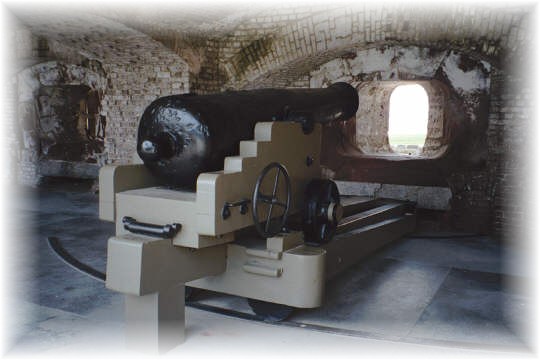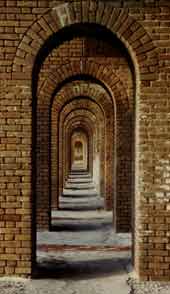To: snippy_about_it; All
Fort Sumter
Confederate Stronghold, 1863-1865
With Fort Sumter in Confederate hands, the port of Charleston became an irritating loophole in the Federal naval blockade of the Atlantic coast. In two months of 1863, 21 Confederate vessels cleared Charleston Harbor and 15 entered. Into Charleston came needed war supplies; out went cotton in payment. To close the port -- and also capture the city -- it was necesary first to seize Fort Sumter, now repaired and armed with some 95 guns. After an earlier Army attempt had failed on James Island, the job fell to the U.S Navy, and Rear Adm. Samuel F. Du Pont was ordered to take the fort.
On the afternoon of April 7, 1863, nine armored Monitor vessels steamed slowly into the harbor and headed for Fort Sumter. For 2 and /12 hours the ironclads dueled with Confederate batteries in the forts and around the harbor. The attack only scarred and battered Sumter's walls, but the far more intense and accurate Confederate fire disabled five Federal ships, one of which, the "Keokuk," sank the next morning.
When the ironclads failed, Federal strategy changed. Du Pont was removed from command and replaced by Rear Adm. John A. Dahlgren, who planned to combine land and sea operations to seize nerby Morris Island and from there to domolish Fort Sumter. At a position secured by U.S. forces on Morris Island, Union troops under Brig. Gen. Quincy A. Gillmore began to place rifled cannon powerful enough to breach Sumter's walls.
Meanwhile, Confederate laborers and slaves inside Fort Sumter worked day and night with bales of cotton and sand to buttress the walls facing the Federal guns. The fort's garrison at this time consisted of five companies of the First South Carolina Artillery under Col. Alfred Rhett.
Federal troops fired a few experimental rounds at the fort in late July and early August. The bombardment began in earnest on August 17, with almost 1,000 shells being fired the first day alone. Within a week, the fort's brick walls were shattered and reduced to ruins, but the garrison refused to surrender and continued to repair and strengthen the defenses.

Palmetto-log reinforcements on the channel side wall of the Fort
Confederate guns at Fort Moultrie and other points now took up the defense of Sumter. Another Federal assault on September 9 fell short; this time the attackers lost five boats and 124 men trying to take the fort from Maj. Stephen Elliott and fresh Confederate troops under his command. Except for one ten-day period of heavy firing, the bombardment continued intermittently until the end of December. By then, Sumter's cannon were severely damaged and dismounted and its defenders could respond with only "harmless musketry."
In the summer of 1864, after Maj. Gen. John G. Foster replaced Gillmore as commander of land operations, the Federals made one last attempt to take Sumter. Foster, a member of Anderson's 1861 garrison, believed that "with proper arrangements" the fort could be taken "at any time." A sustained two-month Union bombardment, however, failed to dislodge the 300-man Confederate garrison and Foster was ordered to send most of his remaining ammunition and several regiments of troops north to aid Grant's campaign against Richmond.
Desultory fire against the fort continued through January 1865. For 22 months Fort Sumter had withstood Federal seige and bombardment, and it no longer resembled a fort at all. But defensively it was stronger than ever. Big Federal guns had hurled seven million pounds of metals at it, yet the Confederate losses during this period had been only 52 killed and 267 wounded.
Gen. William T. Sherman's troops advancing north from Savannah, however, caused the Confederate troops to be withdrawn, and Fort Sumter was evacuated on February 17, 1865.
96 posted on
10/09/2003 7:13:36 PM PDT by
SAMWolf
(Blame Saint Andreas - it's all his fault.)
To: snippy_about_it; All
Fort Sumter
From Wartime Ruin to National Monument
When the Civil War ended, Fort Sumter presented a very desolate appearance. Only on the left flank, left face and right face could any of the original scarp wall be seen. The right flank wall and the gorge wall, which had taken the brunt of the federal bombardments were now irregular mounds of earth, sand and debris forming steep slopes down to the water's edge. The fort bore little resemblance to the impressive work that had stood there at the time of the Confederate bombardment in 1861.

Ft. Sumter as it appeared c.1861 During the decade following the war, the Army attempted to put Fort Sumter back into shape as a military installation. The horizontal irregularity of the damaged or destroyed walls was given some semblance of uniformity by leveling jagged p portions and rebuilding others. A new sally port was cut through the left flank; storage magazines and cisterns were constructed. and gun emplacements were located. Eleven of the original first tier gunrooms at the salient and along the right were reclaimed and armed with 10 pounder Parrott guns.
From 1876 to 1897 Fort Sumter was not garrisoned and served mainly as a lighthouse station. During this period maintenance of the area was so poor that the gun platforms were allowed to rot, guns to rust and the area to erode . The impending Spanish-American War , however, prompted renewed activity that resulted in the construction of Battery Huger in 1898 and the installation of two long range 12-inch rifles the following year. Fortunately, the war ended quickly and the guns were never fired in anger.

Ft. Sumter today During World War I, a small garrison manned the rifles at Battery Huger. For the next 20 years, however, although maintained by the Army, the fort was not used as a military establishment. But it did become a destination for tourists until World War II brought about the fort's reactivation. The battery Huger rifles were removed about 1943 and two 90-mm antiaircraft guns were located along the fort's right flank. Fort Sumter became a national monument in 1948.
98 posted on
10/09/2003 7:18:58 PM PDT by
SAMWolf
(Blame Saint Andreas - it's all his fault.)
To: SAMWolf; snippy_about_it; Victoria Delsoul; colorado tanker; E.G.C.
Gen. William T. Sherman's troops advancing north from Savannah, however, caused the Confederate troops to be withdrawn, and Fort Sumter was evacuated on February 17, 1865. Oh, but Sherman was reviled, and is, to this day.
As the Italian villagers would lynch the downed American aircrews.
Why, they wrecked havoc on their structures, killed their families.
So it is the business of war to break things and kill people until the enemy surrenders.
Lee saw four years of war ahead at the beginning.
In the end, when all has been said about concentration of this and center of gravity of that, it is about will.
What began with the exchanges between gentlemen was ended with the treaty signed by gentlemen.
Betwixt it was--what else--hell.


From Robert Anderson's 18 April 1861 dispatch after boarding the steamship Baltic:
"Having defended Fort Sumter for thirty-four hours, until the quarters were entirely burned, the main gates destroyed by fire, the gorge walls seriously injured, the magazine surrounded by flames, and its door closed from the effects of heat, four barrels and three cartridges of powder only being available, and no provisions remaining but pork, I accepted terms of evacuation offered by General Beauregard, being the same offered by him on the 11th instant, prior to the commencement of hostilities, and marched out of the fort Sunday afternoon, the 14th instant, with colors flying and drums beating, bringing away company and private property, and saluting my flag with fifty guns."



INTERIOR VIEW OF FORT SUMTER
March 1865







110 posted on
10/09/2003 11:07:35 PM PDT by
PhilDragoo
(Hitlery: das Butch von Buchenvald)
FreeRepublic.com is powered by software copyright 2000-2008 John Robinson













